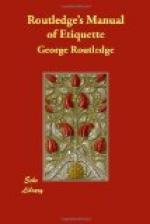[Illustration]
COD-FISH.
Next to turbot, a cod’s head and shoulders is the handsomest dish of fish brought to table. The fish-knife must be passed through the back from 1 to 2, and then transversely in slices. No fish requires more care in helping, for when properly boiled the flakes easily fall asunder, and require a neat hand to prevent the dish looking untidy. With each slice should be sent a portion of the sound, which is the dark lining underneath the back-bone, to be reached with a spoon. Part of the liver may be given if required. The gelatinous part about the eye, called the cheek, is also a delicacy, and must be distributed justly, according to the number of the party.
[Illustration]
SALMON, ETC.
[Illustration]
The best part of a large salmon is a thick piece from the middle. It must be carved by first making an incision down the back, 1 to 2, and a second from 5 to 6; then divide the side 3 to 4, and cut the slices, as preferred, from the upper or thick part, or from the lower richer thin part, or give a little of each. Salmon trout, as it is usually called, haddocks, or large whitings are carved in the same way.
MACKEREL.
It is usual to split the fish from head to tail, and, if not very large, to serve it in two pieces. Most of the smaller fishes may be carved in this way, if too large to serve whole. In every case, one grand rule in carving fish must be attended to—not to break the flakes, and to help compactly, not in detached fragments.
* * * * *
JOINTS.
HAUNCH OF VENISON, OR MUTTON AS VENISON.
It is very necessary that every one who undertakes to carve a haunch of venison should be aware of the responsibility of his duty. An ill-cut or inferior slice, an undue portion of fat, or a deficiency of gravy is an insult to an epicure. The joint must first have a deep incision across the knuckle, 1 to 2, to allow the gravy to flow; then long parallel thin slices along the line 3 to 4, with a portion of the fat, and, if required, of the rich kidney fat lying under the loin; the gravy also, which is, or ought to be, very strong, must be discreetly portioned out according to the number at table. The haunch of mutton must be carved in the same way.
[Illustration]
MUTTON AND LAMB.
SADDLE OF MUTTON OR LAMB.
This very handsome joint is commonly and easily carved in long thin slices from each side of the bone, with a little additional fat cut from the left side. Or, with a little more care, the newer mode may be followed of carving oblique slices from the centre, beginning at the bone near the tail, and cutting the slices through the joint, thus mingling the fat and lean. A saddle of lamb, a pretty dish in season, must be carved in the same way.




